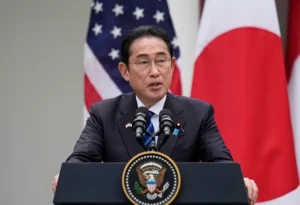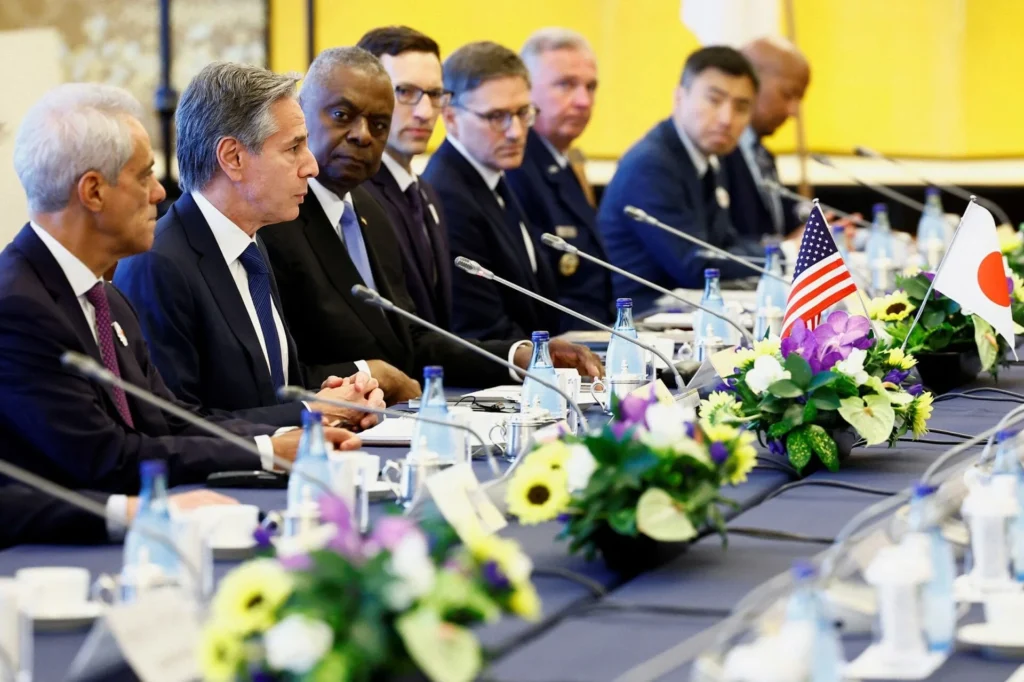The United States and Japan announced a significant revamping of the U.S. military forces stationed here, part of far-reaching efforts to deepen defense cooperation, sources said, modernizing their alliance amid rising security threats in Asia, particularly from China and North Korea. This would represent a historical change in the regional military dynamics.

Strategic Response to Regional Aggression:
This declaration came against the backdrop of an intensified fear of the sharp territorial claims from China and also continued weapons programs in North Korea. Both nations have been trying to build closer relations with Russia, embattled in the conflict in Ukraine. In a communiqué, US Defense Secretary Lloyd Austin and US Secretary of State Antony Blinken, along with their Japanese counterpart ministers of defense and foreign affairs, Minoru Kihara and Yoko Kamikawa respectively, mentioned that activities of China posed a “greatest strategic challenge” in the Asia-Pacific region.
Modernization of the U.S.-Japan Alliance:
The new plan will reconstitute US forces in Japan as a joint force headquarters under the Commander of US Indo-Pacific Command. It aims to deepen interoperability and cooperation on joint bilateral operations, both in peacetime and during contingencies. At a press conference, Austin hailed this decision as the most dramatic change to US Forces Japan since its establishment, marking one of the biggest milestones in the military alliance between the two nations.
“This historic decision will represent the most significant upgrade of US Forces Japan in 70 years, strengthening our military alliance while growing our operational capabilities,” said Austin. Specifically, the plan will involve additional missions and tasks for US Forces Japan while standing up Japan’s new Joint Operations Command, reinforcing the combined ability to deter and respond to coercive behavior in the Indo-Pacific and beyond.
A Unified Defense Strategy:
The announcement enhances commitments made during an April summit between U.S. President Joe Biden and Japanese Prime Minister Fumio Kishida. During that summit, both leaders committed to upgrading their respective command-and-control frameworks to reinforce deterrent capabilities and further promote a free and open Indo-Pacific. A senior US defense official said the details of how it would be implemented would be sorted out by working groups led by US Indo-Pacific Command. He emphasized that there are no plans to integrate Japanese forces into US commands.
Currently, USFJ consists of about 54,000 military personnel based there under a 1960 mutual cooperation and security treaty. The headquarters is at Yokota Air Base.
Japan’s Evolving Defense Posture:
Japan is also reviewing its defense strategy—taking it further and further away from a constitution crafted on pacifism following World War II. It will increase spending on defense to about 2% of its GDP by 2027, adding counterstrike capabilities. This would underscore that Japan is a linchpin in regional security strategy for Washington, but the push toward increased coordination with allies against rising tensions in the region is tougher.
Implications for Regional Security:
The move is almost certain to enrage Beijing, which is wary of the tightening relationship between Washington and Tokyo. China has been busy building its presence in the South China Sea and separately maintaining a fleet near Japanese-controlled islands in the East China Sea. China stands accused of backing up Russia’s war effort in Ukraine—a charge it strenuously denies.
Also, the United States and Japanese officials’ joint statement condemned North Korea’s ballistic missiles test programs and nuclear weapons tests, in addition to the procurement of ballistic missiles and other related materials from North Korea by Russia for use in Ukraine.
Trilateral Coordination with South Korea:
The announcement followed a trilateral meeting between the US, Japanese, and South Korean defense chiefs—the first such meeting to take place in Tokyo. This trilateral coordination demonstrates a turning point for regional relationships as Seoul and Tokyo put aside historical animosities in favor of confronting common security threats. The defense chiefs agreed on increased cooperation to deter a nuclear and missile threat from Pyongyang and unveiled a trilateral pact to formally institutionalize security cooperation between their defense authorities.
Conclusion:
The historic revamping of the U.S. military forces in Japan and further deepening of the defense cooperation between the two countries with regard to a changed security environment in Asia have been strategically done for regional stability, deterrence of aggression, and assurance of a free and open Indo-Pacific. This major step taken shall further strengthen this alliance between the United States and Japan.
